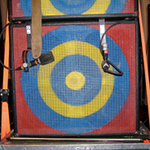Paul B. Jaskot: CAA Book Author Interview
This is the fourth in a series of short interviews with the authors of The Eye, the Hand, the Mind: 100 Years of the College Art Association, the book edited by Susan Ball published in conjunction with CAA’s Centennial.
Paul B. Jaskot
Paul B. Jaskot, professor of the history of art and architecture at DePaul University in Chicago, Illinois, served as president of the CAA Board of Directors from 2008 to 2010. His books include The Architecture of Oppression: The SS, Forced Labor, and the Nazi Monumental Building Economy (2000) and Beyond Berlin: Twelve German Cities Confront the Nazi Past (2008), edited with Gavriel D. Rosenfeld. Jaskot earned a PhD in art history from Northwestern University in Evanston, Illinois, and a BA in history and English from Swarthmore College in Swarthmore, Pennsylvania.
In his conclusion to The Eye, the Hand, the Mind, Jaskot predicted challenges and opportunities facing the organization over the next one hundred years. He emphasizes the importance of the “cross-pollination of ideas and images between artists and art historians” amid a varied audience and educational globalization. In “defining standards and guidelines” in arts education, he asserts that the cultivation of dilated creative and scholarly categories must still coincide with the preservation of more traditional venues of art media and education.
What was the most surprising thing that you learned about CAA during your research and writing?
Before writing the conclusion, I had the privilege of reading all the other contributions. The sense of debate and the intellectual and creative exchange that CAA fosters come through even more strongly than I suspected. As CAA members, we have a deep and diverse history that is surprisingly more complex and contentious than many of us would assume. We often tend to see any learned society as a staid affair; the history in these chapters, however, and the occasional interpretive disagreements among its fifteen authors highlight the opposite.
How has your work on the book changed your perception of the organization?
As a former president, I considered the range of CAA’s activities through the years, from the sponsorship of exhibitions to the engagement with political advocacy. The book helps to reveal the great variability of the organization and, thus, its potential to change with member interest and involvement.
Before joining the book project, many of the contributors worked closely with CAA in various capacities. What were your roles? How important has CAA been to the direction your career has taken?
I cofounded the Radical Art Caucus, a CAA affiliate, in 2001. At the time, the Marxist Caucus had ceased to exist, but several of us thought that some CAA forum that helped us open a discussion about the concrete and critical connection between art and its history and issues such as the distribution of resources and working conditions in the arts would be not only helpful but necessary. With the subsequent US war in Iraq in particular, as well as CAA’s historical role in protecting cultural assets, artists, and intellectuals, the caucus quickly had another set of issues to take on.
In addition, I have also organized and participated in several conference sessions on contingent faculty work in art and art history, art during the Nazi era, and the political history of modern German art. In order to help raise some of these issues that I felt were relevant for the organization as a whole, I ran for the board, was elected in 2004, and later served as vice president for publications and as president.
What were the watershed moments in the areas that you investigated? What do you want readers to take away from your chapter?
I want readers to think about the big picture, not the immediate past or future. Artists and scholars need to embrace digital technologies, sustainability, and the like, of course, but a consideration of the long term hints at seismic changes in how we will communicate in a world dominated by vastly different political, economic, and social interests. For example, the oil economy, as we all know, will be gone sooner rather than later. What impact will such a noncultural event have on the ways we make art and do art history, beyond the obvious? As we look at the massive changes in the past, we should contemplate preparing for disruptions and think about how to sustain critical practices in art and art history in those moments of stress.
How should CAA move forward into the next one hundred years? What has the organization addressed well, and what unexplored territories or constituencies should it begin to explore?
CAA will continue to move forward if its members commit to the highest quality of artistic and scholarly production, nurture economic conditions that protect cultural work, and vigilantly defend that work from those who will try to limit cultural expression.
Originally published on the CAA website on June 28, 2011.
